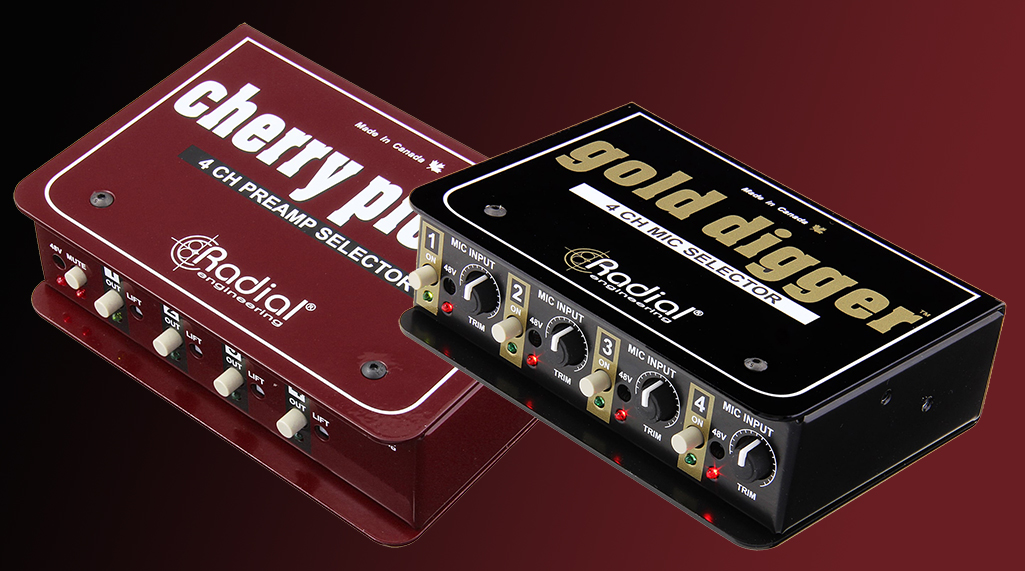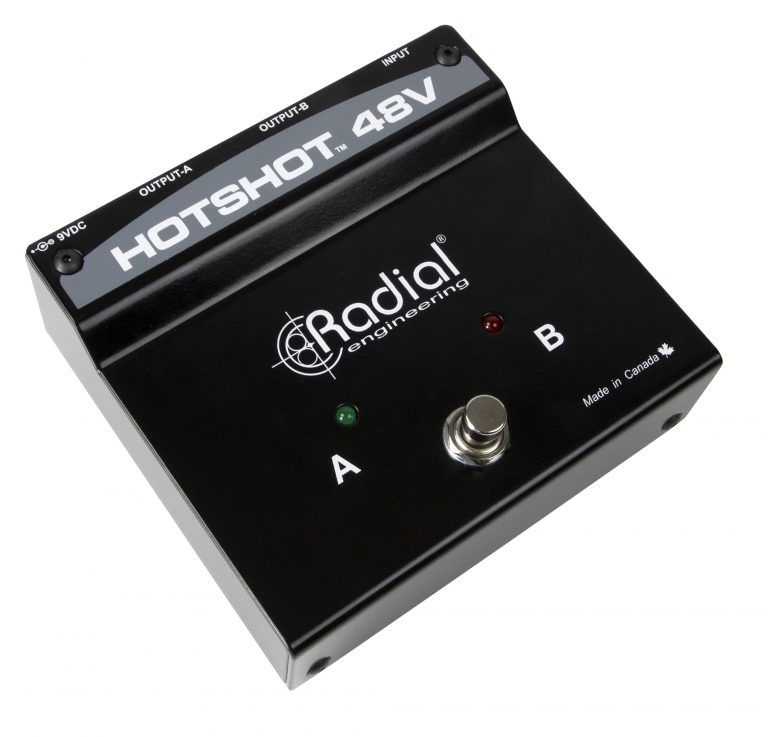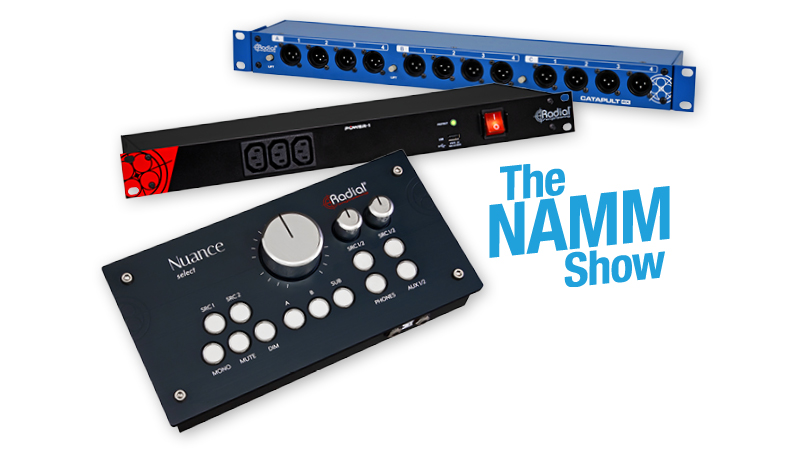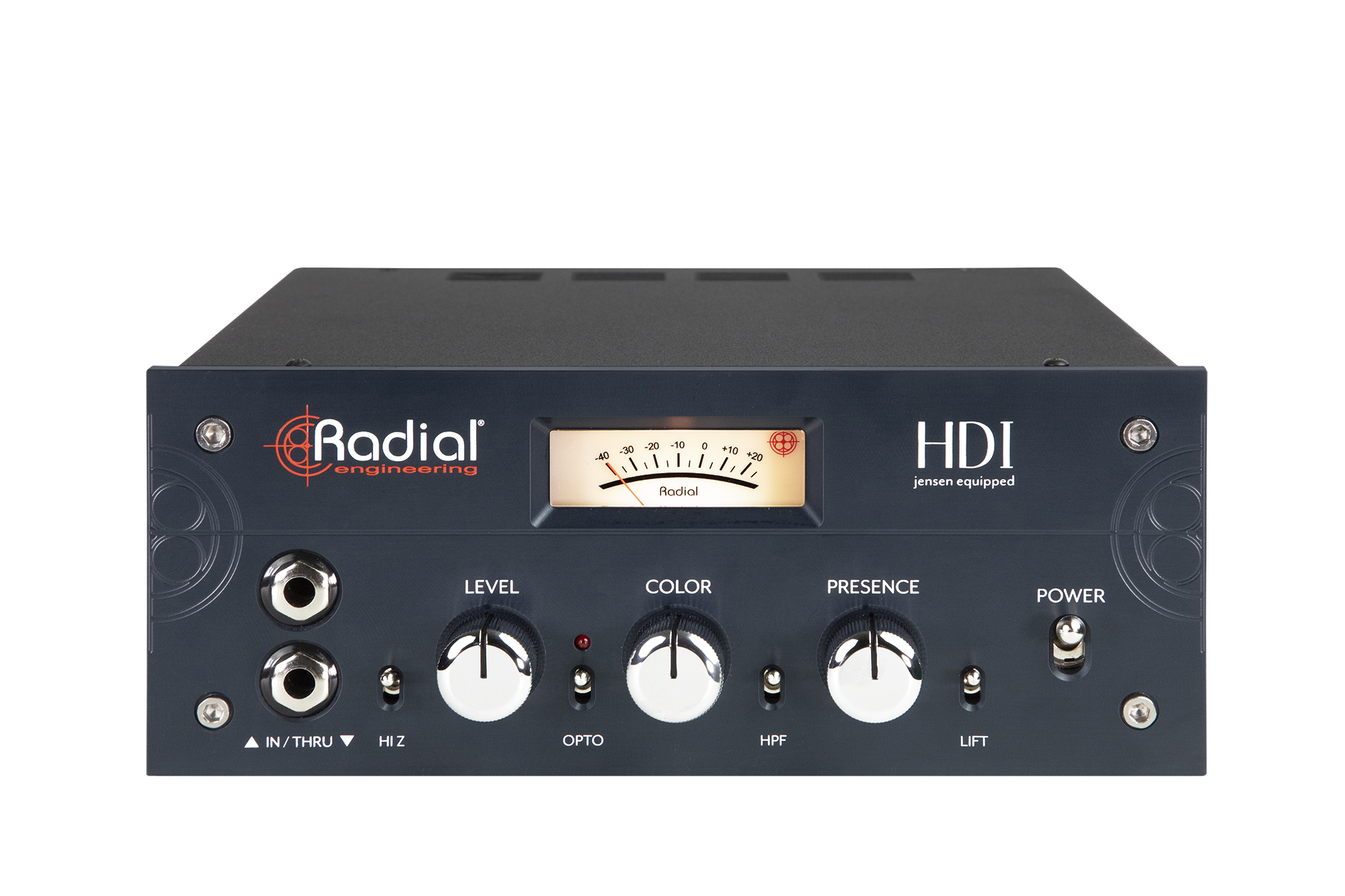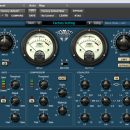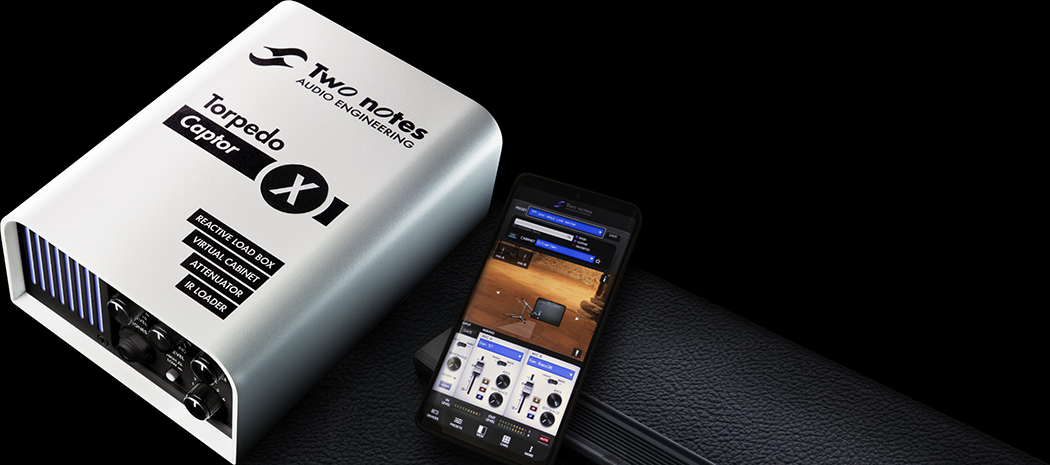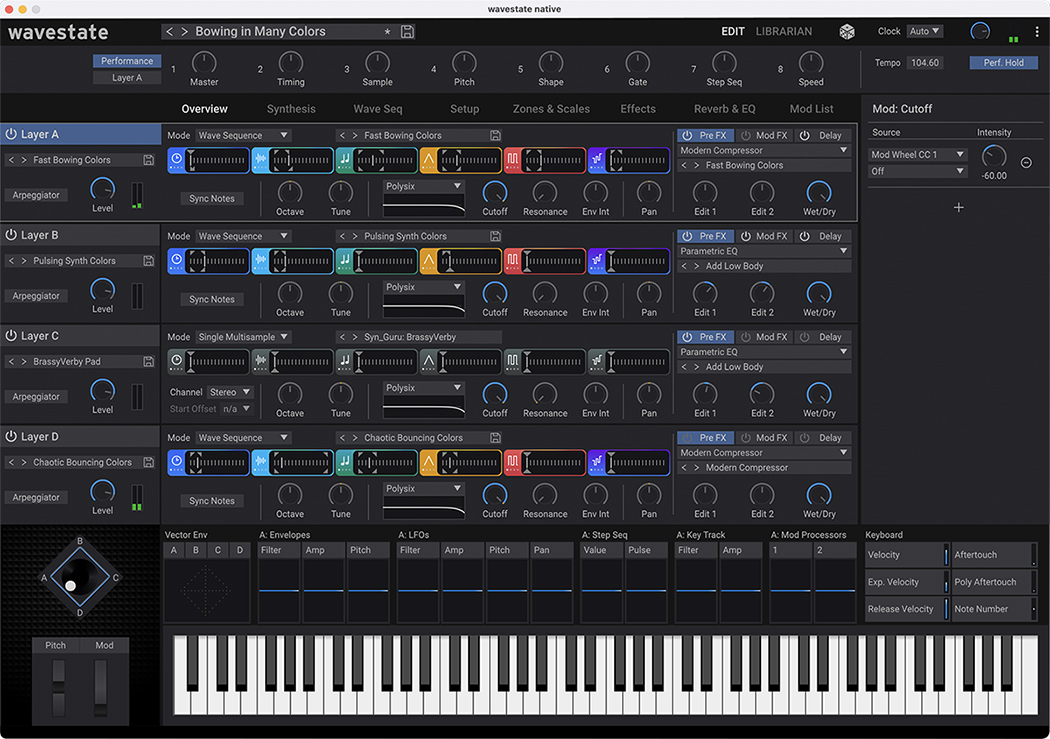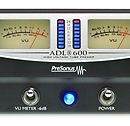 Although Radial Engineering doesn’t make musical instruments, they do help the gear you rely upon sound its best for recording or live performance. We have previously reviewed a number of their products and have always come away finding their products to be best in class both for sonics as well as construction.
Although Radial Engineering doesn’t make musical instruments, they do help the gear you rely upon sound its best for recording or live performance. We have previously reviewed a number of their products and have always come away finding their products to be best in class both for sonics as well as construction.
This review covers two of Radial’s essential studio products, the Gold Digger and the Cherry Picker. In short, the Gold Digger is a four-input, one-output switcher that enables you to choose between multiple microphones feeding a single preamp. The Cherry Picker is the opposite: it is a one-input, four-output switcher that allows you to share one microphone between four preamps. They are useful independently, however we find them to complement each other so well that any studio with multiple mics and multiple preamps would be well served installing a pair of these units.
In our professional project studios, use of the Gold Digger and Cherry Picker for demoing and selecting mics and preamps resulted in significant time savings that enabled us to spend more time focused on our artists and less time making them wait while someone plugs and unplugs a mess of cables. These are amazing accessories that are worth every penny if you’re looking to streamline your workflow.
Features
Although these are two separate, independent products, they share much in common. Both are built like tanks, housed in Radial’s familiar 14-gauage steel enclosures. Both have recessed front panels, and all the XLR and power connections are in the back. Both require power in the form of an included 15V wall wart. Like Radial’s direct boxes, the bottoms have no-slip neoprene foam pads for mechanical and electrical isolation, and both units can be rack mounted—next to each other in the same 1U rack space if desired! The Gold digger is black and, well, gold, while the Cherry picker is, not surprisingly, maroon-colored.
Let’s look at the Gold Digger first: 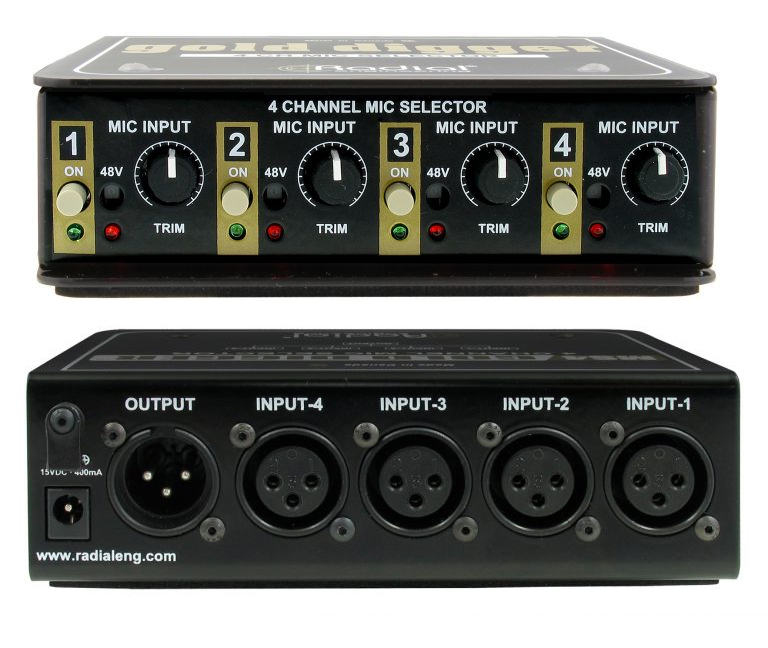 The front panel, which is recessed, allows you to select between the four different input channels. Pushing one of the four radio-style pushbutton switches turns on that channel and turns off all the other channels. To be clear, you can only have one active channel at a time. You can tell which cannel is active as a bright green LED comes on corresponding to the active channel. Each channel has an even further-recessed 48V phantom channel button, which you would need a pen or a screwdriver to push (it was designed this way to prevent accidental on/off switching while in use, which could damage some sensitive mics).
The front panel, which is recessed, allows you to select between the four different input channels. Pushing one of the four radio-style pushbutton switches turns on that channel and turns off all the other channels. To be clear, you can only have one active channel at a time. You can tell which cannel is active as a bright green LED comes on corresponding to the active channel. Each channel has an even further-recessed 48V phantom channel button, which you would need a pen or a screwdriver to push (it was designed this way to prevent accidental on/off switching while in use, which could damage some sensitive mics).
A bright red LED comes on when phantom power is engaged for a given channel. Finally, each channel has a trim control to allow you to adjust levels. This is of particular importance when comparing microphones, as it enables you to match signal levels across mics, which is one of the most essential considerations for objective microphone comparisons.
On the back, you will find four female XLR inputs to connect your microphones. There is also a male XLR connector that connects the output to your mic preamp.
Gold Digger Specs:
| Audio circuit type: | Passive signal path with active relay switching |
| Frequency response: | 10Hz to 100kHz +/- 0.0dB |
| Dynamic range: | >140dB |
| Gain: | 0.0dB – Unity gain device |
| Total harmonic distortion: | 0.0003% |
| Intermodulation Distortion: | 0.001% |
| Phase Deviation: | < 0.001 Degrees at all frequencies |
| Input Impedance: | 600 Ohms (typical) |
| Common Mode Rejection Ratio: | -92dBu @ 55Hz |
| Equivalent Input Noise: | -115dBu |
| Noise: | -140dB |
| Maximum Input: | +26dBu |
| Maximum Output: | +26dBu |
Now let’s look at the Cherry Picker: 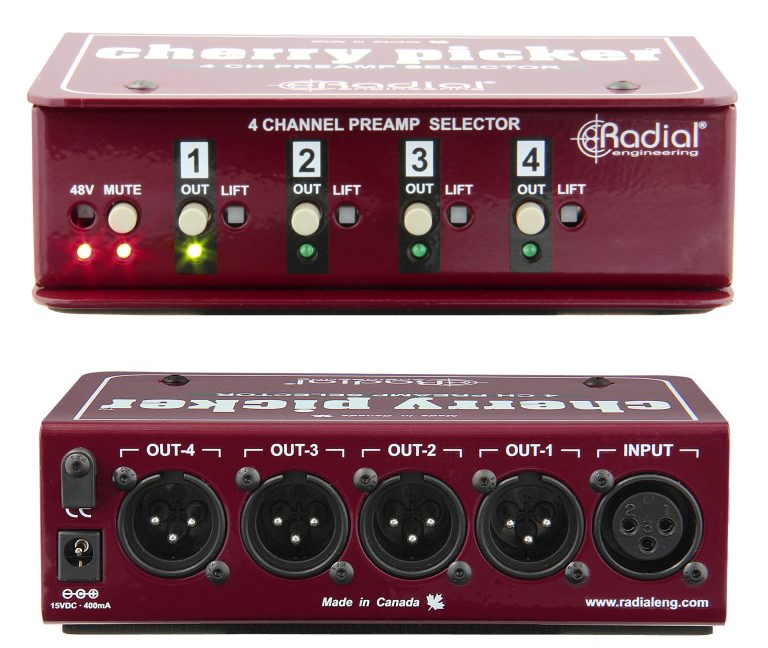
The recessed front panel also sports four channels that are selectable by radio style switches, and an active channel is indicated by a bright green LED. As with the Gold Digger, only one channel can be active at a time. Each channel has a lift button, which disconnects the ground at the XLR output to help eliminate hum and buzz caused by ground loops. In our testing we did not need this, but it’s a nice feature to have if you find yourself battling electric noise or have a finnicky vintage microphone.
Also on the front panel is a 48V phantom power switch, (again) recessed to prevent accidental switching. A red LED illuminates when active on the input channel. Finally, there is a Mute button which turns off all four channels simultaneously; this is to allow you to change your input source without experiencing potential noise being sent to the output channels. This is also designated by a red LED when activated.
The back of the Cherry Picker has four male XLR outputs, and one female XLR input. Although this would most commonly be utilized for a microphone, Radial’s literature states this can be used for any line-level source. By using what Radial calls a “straight wire” passive switcher, no color is added to the signal, allowing for true signal comparison between the different output destinations.
Cherry Picker Specs:
| Audio circuit type: | Passive signal path with active relay switching |
| Frequency response: | 10Hz to 40kHz |
| Dynamic range: | >115dBu |
| Gain: | 0.0dB – Unity gain device |
| Total harmonic distortion: | 0.0003% |
| Intermodulation Distortion: | 0.001% |
| Phase Deviation: | < 0.001 degrees at all frequencies |
| Input Impedance: | 10k Ohms |
| Common Mode Rejection Ratio: | -97dB @55Hz |
| Equivalent Input Noise: | -115dB |
| Maximum Input: | +26dBu |
| Maximum Output: | +26dBu |
Usability
Both units are extremely easy to use. If you can connect a cable, you can use them! Our biggest initial hurdle was rounding up enough premium XLR cords to make all of our connections. Once we did that, then we were in business.
We first tested the Gold Digger by itself. We tested an AT 4047SV, Warm Audio WA-47, and a Shure Beta 58 microphone, routed to an ADL 600 preamp, and recorded into Pro Tools via an Antelope Audio Orion studio interface. Initially we thought there was something wrong with out unit, as we were getting no signal out. When in doubt, RTFM! Radial recommends starting with the trim dials set to maximum, and then dialing down to make the levels among the channels equal. It was then we noticed all our dials were set to zero! Once we increased and balanced the trim levels across mics, we had everything working as expected. Selecting between mics was effortless and quiet.
We next connected the output of the Gold Digger to the input of the Cherry Picker (instead of to our ADL preamp directly). From the Cherry Picker, we routed its outputs to our ADL preamp, a Focusrite ISA 828 preamp, a Focusrite Clarett Octopre, and directly into the Antelope interface itself (which boasts premium preamps as well). Simply put, this was awesome! This also worked smoothly without any issues, and it was a transformative experience to be able to instantly mix and match mics and preamps with literally the touch of a button. Why didn’t we invest in this sooner?
If we did have a minor grievance, it would be about the power supply. Although we understand placing it outside the unit reduces noise, something internal, if possible, would have been great. Additionally, the adaptor connector sticks out from the back of the unit, so something smaller or even right angled might have been better too. Finally, there is no On/Off switch on either unit. While not a huge deal, if you have a rack full of equipment, for example, you might not be using everything in the rack all the time, so being able to turn the power off for items not being is always welcomed (like mics drawing phantom power).
It should be noted that these units may find plenty of use for live sound purposes as well. You could use the Gold Digger to switch mics across different guitar speaker cabinets, or to choose among different mic options for a vocalist in a live show.
Sound
These units don’t generate sounds by themselves. It’s what you plug them into that does! Jokes aside, that is one of the great things about these boxes: they are designed to simply switch signals and not color them I any way (i.e., they don’t contain “colorful” Jensen transformers like some of Radial’s DI boxes do). We didn’t hear any distortion, pops, or any other perceptible change in the quality of the sound of our mics or our preamps as a result of running these boxes as go-betweens.
We can’t understate the value of individual trim levels for the microphones on the Gold Digger. If you have two similar mics and ask your vocalist to sing through each, they will almost always favor the sound of the louder microphone, just as the ear favors louder sounds when comparing takes in a mix. Nailing your level matching across multiple mics enables you to truly evaluate preferences for the sound of your mics on a particular voice. It’s simply impossible to make such unbiased comparisons when manually plugging and unplugging individual mics and adjusting gain levels on-the-fly.
Documentation and Product Support
There are printed manuals included with each unit, a welcome departure from the usual “find it online” approach. While they are both simple to use, there are plenty of diagrams and explanations to get you up in running in no time.
Additionally, there are online videos and diagrams on the Radial website to further assist with questions you may have.
Price
The Radial Engineering Gold Digger and Cherry Picker (MSRP $528 each) can be found online for around $440 per unit. Given that these are sonically pure devices, built like tanks, the price places them well within reach of any studio environment that has invested in multiple mics and/or multiple preamps. Additionally, the improvement in your workflow, whether live or especially in the studio, will be well worth it. We plan on making permanent space in our racks for each of these units, and we suspect you will, too!
Contact Information
Radial Engineering
www.radialeng.com

